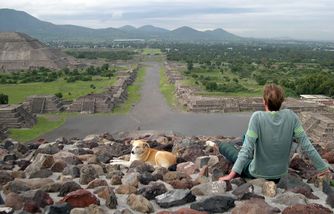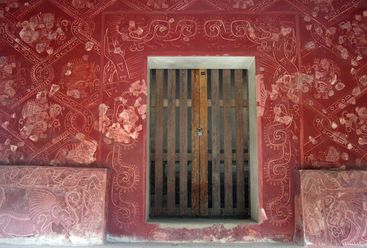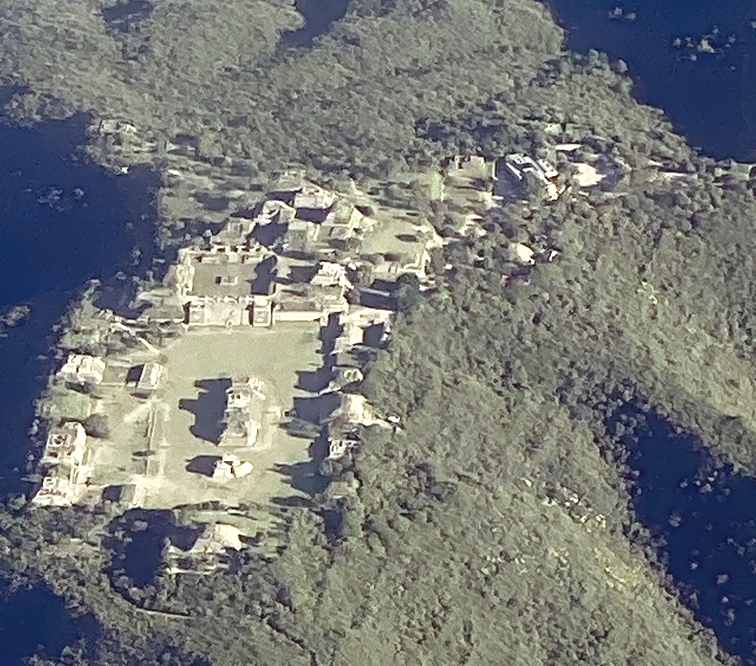
A visitor and his dog, sitting atop the "Pyramid of the Moon," contemplate the "Avenue of the Dead" and the "Pyramid of the Sun" (left). These fanciful names date from Aztec times.
Content created: 2008-08-21
Part 3
Part 5
Modern Mexico City is located on the site of the Aztec capital. Some miles to the northeast of Mexico City lie the impressive ruins of a much earlier city, one that may have been home to 125,000 people at its peak somewhere between AD 300 and AD 500. No one knows what these people called themselves or their city or what language they spoke (although an early form of Náhuatl seems probable). When the Mexica arrived eight hundred years later and saw the huge pyramids and other impressive ruins, they called the place Teotihuácan ("the place where the gods made themselves") the name it bears to this day.

Originally, Teotihuácan seems to have been the largest of several small towns at that end of the Valley of Mexico, and by about AD 100 to have been such an important trading center that the nearest competitors simply faded into uncompetitive oblivion (a kind of implosion that is often seen near growing cities in all historical periods). In the early years, long before its peak, Teotihuácan had a competitor, a town called Cuihcuílco ("place of bright colors"), located in the same valley and, like Teotihuácan, dominating ever more of the surrounding countryside. Cuihcuílco was perhaps home to as many as 20,000 people, probably somewhat more than Teotihuácan at the time. The two towns, Teotihuácan and Cuihcuílco, seemed destined to come into serious conflict. Perhaps they did, but in about AD 100, a volcano (today's Mt. Xictli —"navel") erupted in Cuihcuílco's back yard and buried the entire settlement it its lava flow. This left Teotihuácan as the clearly dominant place and set the stage for extensive growth.
We know nothing of the way in which Teotihuácan related to its surrounding countryside. The enormous labor required to construct its buildings was somehow recruited, willingly or (more probably) not. The site is laid out on a grid of streets, suggesting impressive central planning, as though at some time early in its history someone (who?) anticipated its great size and planned ahead for it. And in the ruins archaeologists have located both workshops that seemed to be producing for a huge market and evidence interpreted as possibly the housing of traveling merchants organized by their home districts.

In other words, Teotihuácan may have been the center of a tributary empire of conquered settlements or territories involuntarily rendering tribute. Or it may not. It was clearly the biggest thing in central Mexico in its glory days, and if it was indeed a tributary empire, or even looked like one, it could very well have provided a model and inspiration for later towns to follow once Teotihuácan faded from the scene. It was clearly an exporter of trade goods and with them of ideas (represented in archaeology partly by buildings in other parts of Mexico that copy features of the architectural style set in Teotihuácan). So distinctive was the age of Teotihuácan that it became the lynchpin for the terms archaeologists use to talk about time in Mexico: The Age of Teotihuácan became, by definition, the center of the "Classic" period. [Note 2]

Like all human societies, that of Teotihuácan did eventually fade. It was abandoned abruptly not long after AD 600, and most archaeologists believe it was sacked. As far as one can tell, it had no serious rival powerful enough to do that, so if it was sacked, we may suspect an uprising by a coalition of adjacent settlements, possibly the great site's tributary subordinates, wearied of offering tribute to the self-proclaimed lords of Teotihuácan. That scenario, if it could be confirmed, would be similar to the later fate of the Aztecs (and perhaps Toltecs), as we shall see, and would conform to the general model of tributary states and their vulnerability.
The fall of a dominant power, however oppressive it may have been, leads more often to conflict and chaos than to peace or gentility. Insofar as we regard Teotihuácan as an early empire, we can easily imagine that its collapse led almost surely to a power vacuum of warring successor states, none of them successful in reestablishing the centralized control or architectural majesty of Teotihuácan.
| « Part 3 |
Contents Glossary, Bibliography | Part 5 » |